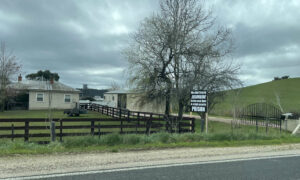Media release – Bob Brown Foundation, 18 August 2021
World’s largest barn owl in Tarkine site where miner wants to dump heavy metals waste
Conservationists have recorded the endangered Tasmanian masked owl in the takayna/Tarkine high conservation value forests targeted for a toxic waste dump by Chinese state-owned mining company MMG.
Bob Brown Foundation researchers have also confirmed the presence of a critically endangered forest community in the area.
“The world’s largest barn owl, the endemic Tasmania masked owl is threatened by a toxic proposal to dump 25 million cubic metres of mine waste into a remarkable world heritage valued site in Tasmania’s northwest. As the world is suffering from the dual climate and biodiversity crises, here in Tasmania, alternatives must be used for mines,” Bob Brown Foundation’s Campaign Manager Jenny Weber said.
“MMG surveys of threatened species were grossly insufficient when the company commenced its destruction for the project. It’s high time this project was ruled out. Until it is ruled out, our foundation is planning to return to frontline protests if the miner returns to continue the destruction of forests and wildlife habitat at the site,” Jenny Weber said.
“The Minister for the Environment, Sussan Ley, recently released a statement of reasons for declaring the waste dump proposal as a controlled action. It said the heavy metals waste dump is likely to be a significant impact on the Tasmanian wedge-tailed eagle, Tasmanian devil, and Tasmanian forests and woodlands dominated by black gum or Brookers gum ecological community,” Jenny Weber said.
“We are not going to leave the assessment of impacts to the mining company that wants to demolish 140 hectares of primeval rainforests and endangered species habitat in takayna/Tarkine. Our foundation has engaged scientists who will lead expert assessments of the flora and wildlife in these world heritage value forests, while also hosting citizen science trips into the ancient forest landscape,” Jenny Weber said.
“The Federal Department of Environment noted that the company referral did not include analysis of potential impacts to listed threatened species and ecological communities as a result of a major dam failure. Our requests to MMG to give us their flood mapping and analysis in the case of a major dam failure went unanswered. The 2020 United Nations Environment Program’s Global Industry Standard on Tailings Management, developed following dam failure in Brazil, aims at zero harm to people and the environment. There is no rhyme or reason where a new tailings waste facility in Tasmania’s takayna rainforests, with critical habitat for the endangered masked owl, and the long list of other endangered species can be measured as zero harm to the environment,” Jenny Weber said.
Featured image: masked owl, courtesy Matthew Newton.
Statement of Reasons for a Decision on Controlled Action Under the Environment Protection and Biodiversity Conservation Act 1999
I, KIM FARRANT, Assistant Secretary, Environment Assessments (Vic, Tas) and Post Approvals Branch, Environment Approvals Division, Department of Agriculture, Water and the Environment, delegate for the Minister for the Environment, provide the following statement of reasons for my decision of 12 July 2021, under section 75 of the Environment Protection and Biodiversity Conservation Act 1999 (EPBC Act), that the proposed action by MMG AUSTRALIA LIMITED to construct and operate a new tailings storage facility and associated infrastructure including roads, pipeline, pipeline bridge, dams, and water outfall infrastructure, approximately 1 km west of the town of Rosebery, in western Tasmania (EPBC 2021/8909), is a controlled action under the EPBC Act and the controlling provisions are sections 18 and 18A (listed threatened species and communities).
LEGISLATION
1. Relevant excerpts of the EPBC Act are set out in Annexure A.
BACKGROUND
2. On 10 May 2021, MMG AUSTRALIA LIMITED (the proponent) referred a proposal to construct and operate a new tailings storage facility and associated infrastructure including roads, pipeline, pipeline bridge, dams, and water outfall infrastructure, approximately 1 km west of the town of Rosebery, in western Tasmania (the proposed action).
3. The proposed action area is located in the region known as the Tarkine, is adjacent to Lake Pieman, and is comprised primarily of continuous vegetation including rainforest.
4. The proposed action includes the following components:
• a tailings storage dam, stated to be around 75 ha
• a polishing pond, stated to be around 25 ha
• several borrow pits, around 23 ha within the footprint of the tailings storage dam footprint, and approximately 40 ha additional to the dam footprint
• a tailings delivery pipeline network for material transport between Rosebery Mine and the proposed tailings storage dam
• a bridge across Lake Pieman for the pipeline, pedestrians, power, and light vehicles
• new access tracks and access track improvements
• a pump station (location to be confirmed)
• environmental outfall (tailings water discharge facility)
• upgrades to several km of Heligog Rd.
5. The proposed action will have a disturbance footprint of at least 140 ha and up to 285 ha.
Description of the environment
6. The vegetation identified in the proposed action area includes rainforest, wet eucalypt forest, and low-lying non-eucalypt vegetation such as Melaleuca swamp forest and button grass moorland, and that large areas of vegetation that may be impacted have not been identified or mapped. The proposed action area is situated in the Pieman catchment, adjacent to Lake Pieman, and that McKimmie Creek flows through the proposed action area and flows into Lake Pieman. The area is currently managed by Sustainable Timber Tasmania, and the proposed bridge will cross land owned by Hydro Tasmania and Department of Primary Industries, Parks, Water and the Environment (DPIPWE).
Referral decision
7. As noted above, on 10 May 2021, a valid referral was received by the department from the proponent in accordance with section 68 of the EPBC Act. The proponent stated that they believed that the proposal was not a controlled action if undertaken in a particular manner for the purposes of the EPBC Act.
8. In accordance with section 74(3) of the EPBC Act, the referral was published on the department’s website on 10 May 2021 and public comments were invited for a period of 10 business days, until 24 May 2021.
9. On 10 May 2021, in accordance with section 74(1) of the EPBC Act, comments on the referral were invited from the following Commonwealth Ministers having administrative responsibilities relating to the proposed action:
• The Hon David Littleproud MP, then Minister for Agriculture, Drought and Emergency Management (currently Minister for Agriculture and Northern Australia)
• The Hon Keith Pitt MP, then Minister for Resources, Water and Northern Australia (currently Minister for Resources and Water)
• The Hon Ken Wyatt AM MP, Minister for Indigenous Australians.
10. On 10 May 2021, in accordance with section 74(2) of the EPBC Act, comments on the referral were invited from Mr Wes Ford, Director of the Tasmanian Environment Protection Authority (EPA), as a delegate for the Tasmanian Minister for Environment, The Hon Roger Jaensch MP.
11. On 4 June 2021, in accordance with sections 75(7) and 88(5) of the EPBC Act and in agreement with the proponent, I decided to extend the referral and assessment approach decision timeframes until 23 July 2021.
12. On 23 June 2021, the proponent provided additional information to the department in the form of an Updated North Barker Ecological Services Flora and Fauna Habitat Assessment Report (The NBES Report).
13. On 12 July 2021, I decided that the proposed action is a controlled action under section 75 of the EPBC Act, and that sections 18 and 18A are the controlling provisions.
EVIDENCE OR OTHER MATERIAL ON WHICH MY FINDINGS WERE BASED
14. In making the decision, I took into account a recommendation brief prepared by officers of the department (the referral decision brief), which I signed on 12 July 2021. The brief had the following attachments:
a. The referral documentation and attachments that were submitted to the department by the proponent in relation to the proposed action, including the NBES Report.
b. The Environmental Reporting Tool (ERT report) report dated 26 May 2021;
c. Decision notice;
d. Public comments;
e. Comments from Commonwealth and State Ministers;
f. Letters to proponent and other relevant parties;
g. Fee schedules with and without justifications;
h. Weekly species report; and
i. Suspension of timeframe decision package.
Public submissions
15. I noted that 35 public comments were received, 13 of which were received after the statutory public comment period closed on 24 May 2021.
16. In accordance with section 75(1A), I considered all public comments received in response to the invitation to comment within the public comment period. I also considered 13 public comments received after this period.
17. I considered the summary of public comments provide to me by the department.
18. In particular, I noted that comments from the public raised issues including the following:
• Opposition to the project, and that it should be a controlled action or clearly unacceptable
• Concerns about the large size of the area of native vegetation that will potentially be removed
• Concerns of impacts to (unlisted) heritage values of the site (environmental and Indigenous) and to EPBC-listed species and ecological communities, including:
o Tasmanian Wedge-tailed Eagle (Aquila audax fleayi) – endangered
o Masked Owl (Tyto novaehollandiae castanops (Tasmanian population)) – vulnerable
o Tasmanian Devil (Sarcophilus harrisii) – endangered
o Gould’s Petrel (Pterodroma leucoptera leucoptera) – endangered
o Spotted-tailed Quoll (Dasyurus maculatus maculatus (Tasmanian population)) – vulnerable
o Swift parrot (Lathamus discolor) – critically endangered
o Tasmanian Forests and Woodlands dominated by black gum or Brookers gum (Eucalyptus ovata / E. brookeriana) – critically endangered
• Concerns that the referral did not substantiate its conclusions regarding lack of impacts to threatened species and ecological communities
• The potential for introduction of declared weeds and disease to the site, such as Phytophthora cinnamomi and myrtle rust, and for chemical seepage, pollution, and environmental harm
• Concerns that the effort of surveys provided were insufficient, including that the study area is too small and does not include several major project components and that invertebrates, fungi, and smaller plants were not well documented
• Querying the usage of borrow pits rather than importing material from the nearby mine and advocating for the usage of alternatives.
• Concerns that the proposed action area is an important carbon sink and should not be cleared
• Concerns that the proponent is a company majority owned by a foreign government which may profit at the expense of Australia’s environment.
Comments from Commonwealth Ministers
19. I noted that a delegate of the Minister for Agriculture, Drought and Emergency Management responded on 25 May 2021, stating that Minister Littleproud had nil comment.
20. I noted that the National Indigenous Australians Agency (NIAA) responded on 24 May 2021, on behalf of the Minister for Indigenous Australians. The NIAA noted that the proponent had failed to consult with Indigenous stakeholders as of yet and recommended that the proponent consult with Circular Head Aboriginal Council and the Tasmanian Aboriginal Centre and seek legal advice regarding the applicability of the future acts regime of the Native Title Act 1993 (Cth). The NIAA encouraged the proponent to engage Indigenous employees and businesses.
21. I noted that Geoscience Australia responded on 21 May 2021, on behalf of the Minister for Resources, Water and Northern Australia, stating that the proposed action is not a nuclear action nor does it raise any water issues related to coal seam gas or large coal mining development.
Comments from State Ministers
22. I noted that Mr Wes Ford, Director of the Tasmanian Environment Protection Authority, responded on 27 May 2021, on behalf of the Tasmanian Minister for Environment. Mr Ford stated that he did not have any information to provide as to whether the proposal is likely to have a significant impact on any of the matters protected under the EPBC Act, and advised that the bilateral assessment agreement was likely to apply if the referral was determined to be a controlled action.
FINDINGS ON MATERIAL QUESTIONS OF FACT
Referral of a larger action
23. Before determining whether the proposed action was a controlled action, I considered whether the action that is the subject of the referral is a component of a larger action the proponent proposes to take, and if so, whether I should decide to not accept the referral of the proposed action pursuant to the discretion under section 74A(1) of the EPBC Act.
24. I noted that the proposed action is related to a larger project as it will enable the continued operation of the MMG Rosebery Mine. However, I also noted that the proposed action is not
42026785
known to be dependent on other future components proposed to be taken by the proponent that have not yet been referred. Rather, it is related to the existing operations of the MMG Rosebery Mine which has been in operation for over 80 years, pre-dating the EPBC Act.
25. I considered that the proposed action was not ‘a component of a larger action the person proposes to take’ under section 74A(1).
26. I considered that acceptance of the proposed action referral would allow me to assess all impacts of the proposed project.
27. As I concluded that the referred action was not part of a larger action that the person proposes to take, I did not need to decide whether or not to accept the referral for the purposes of section 74A(1) of the EPBC Act.
Part 3 provisions that are controlling provisions
28. Section 75(1) of the EPBC Act, provides that, as a delegate of the Minister, I must decide whether the proposed action is a controlled action, and which provisions of Part 3 (if any) are controlling provisions for the action.
29. For the reasons set out below, I found that there was a likelihood that the proposed action would have a significant impact on a matter protected by Part 3 of the EPBC Act, namely the matters protected by sections 18 and 18A (listed threatened species and communities).
30. In accordance with section 75(2) of the EPBC Act, in making my decision, I considered all adverse impacts that the proposed action has or will have or is likely to have on matters protected under Part 3 of the EPBC Act. I did not consider any beneficial impacts that the proposed action has or will have, or is likely to have, on matters protected under Part 3 of the EPBC Act.
31. I noted that the department’s ERT report dated 26 May 2021 identified 16 listed threatened species and 2 threatened ecological communities that may occur within 10 km of the proposed action.
32. I considered the department’s EPBC Act Policy Statement 1.1 Significant Impact Guidelines – Matters of National Environmental Significance (2013) (Significant Impact Guidelines) which provide overarching guidance on determining whether an action is likely to have a significant impact on a matter protected under the EPBC Act. It is a policy document, not a legal instrument. However, I considered that the guidance is an appropriate way to assess the likely impact of particular actions on listed threatened species.
33. In making my decision, I considered information provided in the NBES report and referral documentation, as well as submissions received on the referral from the public and on behalf of Commonwealth and State Ministers. I noted that the on-foot studies conducted to inform the NBES report did not encompass the entire referred action footprint, and only occurred over an area of 128.5 ha (henceforth the study area) rather than the 285 ha polygon provided in the referral documentation (henceforth proposed action area). I noted that the survey effort for those studies was limited.
Wedge-tailed Eagle (Tasmanian) (Aquila audax fleayi) – endangered
34. I considered the species information provided by the department in the decision brief and sourced from the department’s Species Profile and Threats Database (SPRAT) on the Tasmanian Wedge-tailed Eagle. I noted that The Tasmanian Wedge-tailed Eagle is endemic to Tasmania and is a large bird of prey that occupies a range of habitats, from dense eucalypt forest to open grassland. The main identified threats for the Tasmanian Wedge-tailed Eagle include loss of nesting habitat and disturbance of nesting birds and, to a lesser degree, persecution by humans.
35. The NBES report stated that a known Tasmanian Wedge-tailed Eagle nest may occur within 500 m of the proposed action area.
36. The NBES report also stated that the entirety of the study area had been surveyed via helicopter, which verified the nest and identified no further nests within 1 km of the study area.
37. The NBES report identified suitable nesting habitat within and surrounding the proposed action area.
38. Having regard to the mapping of the proposed project components provided in the referral attachments, and the department’s advice, I determined that the known nest may be closer than 500 m to a potential access track and the tailings storage facility.
39. The Threatened Tasmanian Eagles Recovery Plan: 2006-2010 records habitat critical to the survival of the Tasmanian Wedge-tailed Eagle as nesting habitat free from disturbance and considers that disturbance of nests is a key threat to the species. The Threatened Tasmanian Eagles Recovery Plan: 2006-2010 considers breeding season buffers against disturbance of 500 m and 1000 m in line-of-sight appropriate to protect nests from disturbance, and lists reducing the proportion of nests subject to disturbance and increasing breeding success as specific objectives. I noted departmental advice that disturbed nest areas are very rarely reoccupied by eagles for breeding purposes.
40. The NBES report stated that the known nest is within 500 m of an operational train line and therefore disturbance had not impacted the nest. Information on the train’s operations was not provided.
41. I determined that in the absence of information about the train’s operations and acknowledging the differing characteristics of construction disturbance, the occurrence of existing disturbance caused by a different action did not mean that further and increased disturbance would not disrupt the breeding cycle for eagles utilising the nest.
42. Given the suitable nesting habitat identified by the NBES report within and surrounding the proposed action area, I considered that the construction of the proposed tailings storage dam and access track may result in the loss of potential critical habitat to the species, being high quality nesting habitat free from disturbance.
43. The referral stated that an eagle nest management plan may need to be developed to allow for disturbance works to be undertaken outside of the July to February breeding season. As no such plan had been developed or provided by the proponent, I could not assess its adequacy.
44. The Significant Impact Guidelines suggest that an action is likely to have a significant impact on an endangered species if there is a real chance or possibility that it will adversely affect habitat critical to the survival of a species disrupt the breeding cycle of a population.
45. Accordingly, I concluded that the proposed action is likely to have a significant impact on the Tasmanian Wedge-tailed Eagle, as there is a real chance or possibility that the proposed action will result in loss of habitat critical to the species and disrupt the breeding cycle of a population.
The Tasmanian Forests and Woodlands dominated by Black Gum or Brookers Gum (Eucalyptus ovata / E. brookeriana) ecological community – critically endangered
46. I considered the ecological community information provided by the department in the decision brief and sourced from the department’s SPRAT profile on the Tasmanian Forests and Woodlands dominated by Black Gum or Brookers Gum (Eucalyptus ovata / E. brookeriana) ecological community (EC). I noted that the EC is a type of forest endemic to Tasmania, dominated or co-dominated by either E. ovata or E. brookeriana. The species composition of this ecological community includes a mixture of Eucalyptus, Melaleuca (paperbark), Acacia (wattle), and Leptospermum (tea-trees) in the canopy and mid-storey. It is essential habitat for a variety of fauna, including quoll species and Tasmanian Devil, and generally occurs on low-lying damp sites, including riverine habitats.
47. The NBES report states that this EC was initially recorded in the study area by surveys undertaken on-foot. I noted that NBES report indicates that these surveys covered a study area of 128.5 ha, which is less than half of the referred proposed action area of 285 ha.
48. However, the NBES report referred to subsequent helicopter surveys for E. brookeriana, and concluded that the species was subdominant, and therefore, in their opinion that part of the study area no longer qualified to be recorded as containing the threatened EC.
49. The NBES report stated that helicopter surveys identified widely spaced very large E. obliqua dominated parts of the forest, and parts of the forest with E. brookeriana present dominated by E. nitida, determined due to higher stem density.
50. The Approved Conservation Advice – Tasmanian Forests and Woodlands dominated by black gum or Brookers gum (Eucalyptus ovata / E. brookeriana) (2019) advises that ‘thorough and representative on-ground surveys are essential to accurately assess the extent and condition of the ecological community’. I noted that the proponent had not provided evidence that such surveys had been conducted. As the helicopter vegetation survey report was not provided by the proponent, I could not assess its adequacy.
51. I noted that this EC was initially recorded onsite via on-foot surveys which according to the Approved Conservation Advice – Tasmanian Forests and Woodlands dominated by black gum or Brookers gum (Eucalyptus ovata / E. brookeriana) (2019) are preferable to helicopter surveys. I considered that that the currently available survey information is insufficient to determine the quality, extent or rule out presence of the EC within the study area and noted that less than half of the area referred had been studied on foot. Accordingly, I determined I could not rule out that this EC is present within, or in close proximity to, the proposed action area.
52. I determined that given that E. brookeriana is sufficiently abundant within the initial 128.5 ha study area, the area was initially classified as the EC due to perceived dominance. I could not rule out that this EC may also be present elsewhere within, or in close proximity to, the proposed action area.
53. The Approved Conservation Advice – Tasmanian Forests and Woodlands dominated by black gum or Brookers gum (Eucalyptus ovata / E. brookeriana) (2019) advises that threats to this EC include clearance, fragmentation, weed invasion, altered hydrology and water quality, and disease and dieback.
54. I considered that the above threats are likely to impact this EC if it is present at the proposed action site.
55. The referral details the potential for the introduction of declared weeds, and pathogens such as Phytophthora cinnamomi, which could impact the EC at this site. The clearance of vegetation for the construction of infrastructure including tailings storage, access tracks, and environmental outfall may remove or fragment this EC. Additionally, the construction of a tailings storage dam and water outflow may alter hydrology and water quality, potentially impacting this EC. The impacts of mine tailings in the area have not been assessed.
56. The Significant Impact Guidelines state that an action is likely to have a significant impact on a critically endangered or endangered ecological community if there is a real chance or possibility that it will: increase fragmentation of an ecological community; modify or destroy abiotic factors such as water necessary for its survival (e.g. substantial alteration of surface water drainage patterns); or cause a substantial reduction in the quality or integrity of an occurrence of an ecological community, such as assisting invasive species that are harmful to an ecological community to become established, or causing regular mobilisation of chemicals or pollutants.
57. I therefore concluded that the proposed action is likely to have a significant impact on the Tasmanian Forests and Woodlands dominated by Black Gum or Brookers Gum (Eucalyptus ovata / E. brookeriana) ecological community, and that further information should be sought through the proposed assessment stage to determine the extent of impacts.
Tasmanian Devil (Sarcophilus harrisii) – endangered
58. I considered the species information provided by the department in the decision brief and sourced from the department’s SPRAT profile on the Tasmanian Devil (Sarcophilus harrisii). I noted that the species is a nocturnal hunter and scavenger, with the main prey species being macropods, possums and wombats. I noted that the Devil Facial Tumour Disease is a major threat to the species and other threats include death from road collision, human persecution and habitat loss and fragmentation.
59. The NBES report stated that there is suboptimal habitat for Tasmanian Devil widespread throughout the study area of 128.5 ha and that it is possible for dens to occur in the proposed action area. I noted that 128.5 ha is less than half of the total referred proposed action area, being 285 ha, and determined that the habitat assessment was not adequate to assess habitat across the proposed action area.
60. The NBES report also stated that no preferred denning structures or evidence of denning was detected. The NBES report also stated that this does not demonstrably rule out the potential for dens to occur elsewhere, and that pre-clearance surveys and further targeted den searches will be required.
61. Tasmanian Devil scats and footprints were recorded in the NBES Report along tracks and roads, and the NBES report acknowledged that there are several records of Tasmanian Devil in the surrounding area.
62. The referral stated that there is potential for impacts to the Tasmanian Devil but concluded that this impact would not be significant given the suboptimal denning habitat present.
63. I note that species density was not assessed in the NBES report.
64. On the basis of above information, I decided that Tasmanian Devil foraging and denning habitat occurs in and around the proposed action area, and that further surveys are needed to determine the quality and extent of this habitat.
65. I noted that the Significant Impact Guidelines state that an action is likely to have a significant impact on a critically endangered or endangered species if there is a real chance or possibility that it will modify, destroy, remove, isolate or decrease the availability or quality of habitat to the extent that the species is likely to decline.
66. I considered that, given the possible presence of the species and its potential usage of the habitat, a significant impact is likely as a result of vegetation clearing of at least 140 ha for the proposed action.
67. I also noted that the referral concludes that an increase in roadkill as a result of the proposed action would cause a small loss of animals but not affect dens, and therefore a significant impact is not likely.
68. The Approved Conservation Advice for Sarcophilus harrisii (Tasmanian Devil) (2009) identifies motor vehicles as a threat to the Tasmanian Devil.
69. I found that the presence of this species and habitat usage adjacent to traffic routes has not been assessed, and that increased road mortality may cause a long-term decrease in the size of the population, potentially a significant impact to the species.
70. The referral has listed several measures to mitigate the impact to Tasmanian Devil, including:
a. requirement for pre-clearance surveys for Tasmanian Devil dens
b. potential requirement for the implementation of traffic hours and speed management.
71. I noted that while these measures may serve to mitigate some impacts to the Tasmanian Devil, these measures do not mitigate or compensate for the potential for as-yet unquantified habitat loss.
72. Additionally, I noted the presence of the species and the extent and quality of the habitat has not been adequately assessed to determine whether the proposed mitigation measures are sufficient.
73. I concluded that given the presence of Tasmanian Devil and Tasmanian Devil denning and foraging habitat in and around the project area, the range and scale of potential impacts and insufficient survey information, a significant impact to the Tasmanian Devil is likely as a result of the proposed action.
Impacts to other species
74. The referral and NBES report state that no listed threatened flora has been identified as present within a 5 km radius of the proposed action, but that an additional summer orchid survey will be undertaken. I noted that NBES had only conducted surveys for listed threatened flora in the footprint of the tailings storage and polishing pond, being the study area.
75. I found that the referral did not include analysis of potential impacts to listed threatened species and ecological communities as a result of dam seepage or a major dam failure. The department advised me that no aquatic listed threatened species had been identified as likely to occur in close proximity to the proposed action, but advised that there may be impacts to listed threatened species further downstream in the Pieman River catchment, including the vulnerable Australian Grayling (Prototroctes maraena) and the endangered Tasmanian Azure Kingfisher (Ceyx azureus diemenensis).
76. Further, on the basis of all the information available to me, including the ERT report (which suggests the presence of the following species or communities in the area of the proposal), the small area studied, and without further detailed assessment of potential impacts in the referral, I considered that the proposed action may significantly impact on other listed threatened species including but not limited to the following:
a. Spotted-tailed Quoll – (Dasyurus maculatus maculatus (Tasmanian population)) – vulnerable
b. Masked Owl (Tasmanian) (Tyto novaehollandae castanops) – vulnerable
c. Native Wintercress (Barbarea australis) – endangered
d. Swift Parrot (Lathamus discolor) – critically endangered
e. Scrambling Groundfern (Hypolepis distans) – endangered
77. On the basis of all the information available to me, including the ERT report, advice provided in the decision brief and the information in the referral documentation, I considered that the proposed action is unlikely to have a significant impact on the vulnerable Giant Tasmanian Crayfish (Astacopsis gouldi). I noted that the Giant Tasmanian Crayfish occurs in northern Tasmania, and that the Atlas of Living Australia records one occurrence of this species more than 50 km north of the proposed action. I noted departmental advice that there are no records of this species in the Pieman Catchment, or in direct hydraulic connections to the Pieman Catchment. I considered and agreed with departmental advice that the species is unlikely to occur in the Pieman Catchment, and that it is therefore is unlikely to be impacted by the proposed action.
78. On the basis of all the information available to me, including the ERT report, advice provided in the decision brief and the information in the referral documentation, I considered that the proposed action is unlikely to have a significant impact on the endangered Gould’s Petrel (Pterodroma leucoptera leucoptera). I noted that Gould’s Petrel is a pelagic marine species and does not occur inland in Tasmania except in very unusual cases. On that basis, I determined that impacts to Gould’s Petrel are unlikely as a result of the proposed action.
Other protected matters that are not controlling provisions
Listed migratory species (sections 20 and 20A)
79. I considered whether the proposed action will have or is likely to have a significant impact on a listed migratory species.
80. I noted the ERT report identified eight listed migratory species that are likely to occur or may potentially occur within 10 km of the proposed action.
81. Based on the information available from the department, including SPRAT and the referral documentation, the department considered, and I agreed, that an ecologically significant proportion of the population of a listed migratory species, or important habitat for a listed
42026785
migratory species is unlikely to occur within the project area or downstream. Additionally, having regard to the habitat present in the proposed action area and the nature of proposed action, I considered there is unlikely to be any significant impact on these species.
82. For these reasons, I determined that sections 20 and 20A are not controlling provisions for the proposed action.
Ramsar Wetlands (sections 16 and 17B)
83. I considered whether the proposed action will have or is likely to have a significant impact on the ecological character of a declared Ramsar wetland.
84. I noted that the ERT report did not identify any Ramsar listed wetland of international importance within or adjacent to the proposed action area.
85. I considered that given the information contained in the referral documentation, the nature and scale of the proposed action and its potential impacts, and the distance to Ramsar listed wetlands of international importance, the proposed action is unlikely to have a significant impact on Ramsar listed wetlands of international importance.
86. For these reasons, I determined that sections 16 and 17B are not controlling provisions for the proposed action.
World Heritage properties (sections 12 and 15A)
87. I considered whether the proposed action will have or is likely to have a significant impact on the World Heritage values of a declared World Heritage property.
88. I noted the ERT report did not identify any World Heritage properties located within or adjacent to the proposed action area.
89. I considered and agreed with advice from the department that are no World Heritage properties within 10 km of the proposed action area. I noted the closest World Heritage property, the Tasmanian Wilderness World Heritage Area, is approximately 13 km from the proposed action area.
90. I considered that, given the information contained in the referral documentation, the nature and scale of the proposed action and its potential impacts, and the distance to World Heritage properties, the proposed action is unlikely to have a significant impact on World Heritage properties.
91. For these reasons, I determined that sections 12 and 15A are not controlling provisions for the proposed action.
National Heritage places (sections 15B and 15C)
92. I considered whether the proposed action will have or is likely to have a significant impact on the National Heritage values of a declared National Heritage place.
93. I noted the ERT report did not identify any National Heritage places located within or adjacent to the proposed action area
94. I accepted advice from the department that there are no National Heritage places within 10 km of the proposed action area. I noted that the nearest National Heritage place, the Western Tasmanian Aboriginal Cultural Landscape, is approximately 40 km from the proposed action area.
95. I considered that given the information contained in the referral documentation, the nature and scale of the proposed action and its potential impacts, and the distance to National Heritage places, the proposed action is unlikely to have a significant impact on National Heritage places.
96. For these reasons, I determined that sections 15B and 15C are not controlling provisions for the proposed action.
Commonwealth marine environment (sections 23 and 24A)
97. I considered whether the proposed action will be taken in a Commonwealth marine area and whether it will have or is likely to have a significant impact on the environment.
98. I noted proposed action does not occur in, or adjacent to, a Commonwealth marine area.
99. I considered that given the information contained in the referral documentation, the nature and scale of the proposed action and its potential impacts, and the distance to a Commonwealth marine area, the proposed action is unlikely to have a significant impact on the environment in a Commonwealth marine area
100. For these reasons, I determined that sections 23 and 24A are not controlling provisions for the proposed action.
Commonwealth action (section 28)
101. I considered whether the proposed action is being taken by the Commonwealth or a Commonwealth agency within or outside the Australian jurisdiction. If so, I would be required to consider whether it will have or is likely to have a significant impact on the environment inside or outside the Australian jurisdiction.
102. I noted that the proponent is not the Commonwealth, nor is it a Commonwealth agency (as defined in the EPBC Act).
103. For this reason, I determined that section 28 is not a controlling provision for the proposed action.
Commonwealth land (sections 26 and 27A)
104. I considered whether the proposed action was being taken on Commonwealth land. If so, I would also be required to consider whether it will have or is likely to have a significant impact on the environment.
105. I noted the proposed action is not being undertaken on Commonwealth land.
106. I considered that given the information contained in the referral documentation, the nature and scale of the proposed action and its potential impacts, and the distance to Commonwealth land, the proposed action is unlikely to have a significant impact on the environment on Commonwealth land.
107. For these reasons, I determined that sections 26 and 27A are not controlling provisions for the proposed action.
Nuclear action (sections 21 and 22A)
108. I considered whether the proposed action is a nuclear action. If so, I would be required to consider whether it will have or is likely to have a significant impact on the environment.
109. I determined proposed action does not meet the definition of a nuclear action as defined in section 22 of the EPBC Act, and noted that Geoscience Australia, on behalf of the Hon Keith Pitt MP (the then Minister for Resources, Water and Northern Australia), responded to the invitation to comment on this referral and advised that the action is not a nuclear action.
110. For these reasons I determined that that sections 21 and 22A are not controlling provisions for the proposed action.
Great Barrier Reef Marine Park (sections 24B and 24C)
111. I considered whether the proposed action is being taken in the Great Barrier Reef Marine Park. If so, I would also be required to consider whether it will have or is likely to have a significant impact on the environment.
112. I noted the proposed action is not being undertaken in the Great Barrier Reef Marine Park.
113. I considered that given the information contained in the referral documentation, the nature and scale of the proposed action and its potential impacts, and the distance to the Great Barrier Reef Marine Park, the proposed action is unlikely to have a significant impact on the Great Barrier Reef Marine Park.
114. For these reasons, I determined that sections 24B and 24C are not controlling provisions for the proposed action.
Commonwealth Heritage places overseas (sections 27B and 27C)
115. I considered whether the proposed action is being taken outside the Australian jurisdiction. If so, I would be required to consider whether it will have or is likely to have a significant impact on the environment in a Commonwealth Heritage place outside the Australian jurisdiction.
116. I noted that the proposed action is not being taken outside the Australian jurisdiction.
117. For this reason, I determined that sections 27B and 27C are not controlling provisions for the proposed action.
A water resource, in relation to coal seam gas development and large coal mining development (sections 24D and 24E)
118. I considered whether the proposed action involves a coal seam gas development or large coal mining development. If so, I would be required to consider whether the action will have or is likely to have a significant impact on a water resource.
119. I accepted advice from the department that proposed action is not a coal seam gas or a large coal mining development, and noted that Geoscience Australia, on behalf of the Hon Keith Pitt MP (the then Minister for Resources, Water and Northern Australia), responded to the invitation to comment on this referral and advised that the proposed action does not raise any water issues related to coal seam gas or large coal mining development.
120. For these reasons, I determined that sections 24E and 24D are not controlling provisions for the proposed action.
Other matters for decision making
Precautionary principle
121. Under section 391(2) of the EPBC Act, I must take into account the precautionary principle in making a decision on whether an action was a controlled action.
122. The precautionary principle provides that lack of full scientific certainty should not be used as a reason for postponing measures to prevent the degradation of the environment where there are threats of serious or irreversible environmental damage.
123. I considered and agreed with departmental advice that there is a lack of full scientific certainty about the impacts of the proposed action on a number of listed species.
124. However, in light of the conclusion that there is likely to be a significant impact on the Tasmanian Wedge-Tailed Eagle, Tasmanian Devil and Tasmanian Forests and Woodlands dominated by Black Gum or Brookers Gum (Eucalyptus ovata / E. brookeriana) ecological community, I determined that the application of the precautionary principle would not affect whether the proposed action is a controlled action.
125. I also noted that the proponent suggested that the proposed action would not be a controlled action if undertaken in a particular manner. However, I agreed with the department’s advice that there is too much uncertainty regarding the particular manner in which the action would be taken and its impacts for this to be an appropriate approach
126. I took the precautionary principle into account, in making the findings set out above, based on the available information in the referral and decision brief, that the proposed action is likely to have a significant impact on the protected matters.
Bioregional Plans
127. In accordance with section 176(5), I am required to have regard to a bioregional plan in making any decision under the Act to which the plan is relevant.
128. There is no bioregional plan that is relevant to my decision.
Management Plans for Commonwealth Reserves
129. In accordance with section 362(2), the Commonwealth or a Commonwealth agency must not perform its functions or exercise its powers in relation to a Commonwealth reserve inconsistently with a management plan that is in operation for the reserve.
130. There is no Commonwealth reserve management plan that is relevant to my decision.
Conclusion
131. I considered that the information before me was adequate for me to make a decision under section 75 of the EPBC Act.
132. In making my decision, I took into account the information provided in the decision brief and its attachments, including:
a. the referral and all of its attachments
b. submissions received from the public and relevant Commonwealth and State Ministers
c. the adverse impacts the proposed action has or will have, or is likely to have, on each matter protected by Part 3 of the EPBC Act, as required under section 75(2)(a) of the EPBC Act.
133. In making my decision, I took account of the precautionary principle as required by section 391 of the EPBC Act.
134. I noted that there were no relevant bioregional plans to consider under section 176 of the EPBC Act.
135. I noted that there were no relevant management plans for Commonwealth reserves to consider under section 362(2) of the EPBC Act.
136. I reviewed the information in the referral against the Significant Impact Guidelines 1.1 and other relevant material contained in the decision brief. While I noted that this material is not binding or exhaustive, the factors identified are considered adequate for decision-making in the circumstances of this referral. I found that adequate information was available to support my decision in relation to the proposed action.
137. Based on this material, and on my findings set out above, I have found that the taking of the proposed action is likely to have a significant impact on listed threatened species and communities (sections 18 and 18A).
138. Accordingly, I decided under section 75(1) of the EPBC Act that the proposed action is not a controlled action.
Signed
……………………………………..
KIM FARRANT
11 August 2021
ANNEXURE A – LEGISLATION
Section 68 of the EPBC Act relevantly provides:
(1) A person proposing to take an action that the person thinks may be or is a controlled action must refer the proposal to the Minister for the Minister’s decision whether or not the action is a controlled action.
(2) A person proposing to take an action that the person thinks is not a controlled action may refer the proposal to the Minister for the Minister’s decision whether or not the action is a controlled action.
Section 74 of the EPBC Act relevantly provides:
Inviting other Commonwealth Ministers to provide information
(1) As soon as practicable after receiving a referral of a proposal to take an action, the Minister (the Environment Minister) must:
(a) inform any other Minister whom the Environment Minister believes has administrative responsibilities relating to the proposal; and
(b) invite each other Minister informed to give the Environment Minister within 10 business days information that relates to the proposed action and is relevant to deciding whether or not the proposed action is a controlled action.
Inviting comments from appropriate State or Territory Minister
(2) As soon as practicable after receiving, from the person proposing to take an action or from a Commonwealth agency, a referral of a proposal to take an action in a State or self-governing Territory, the Environment Minister must, if he or she thinks the action may have an impact on a matter protected by a provision of Division 1 of Part 3 (about matters of national environmental significance):
(a) inform the appropriate Minister of the State or Territory; and
(b) invite that Minister to give the Environment Minister within 10 business days:
(i) comments on whether the proposed action is a controlled action; and
(ii) information relevant to deciding which approach would be appropriate to assess the relevant impacts of the action (including if the action could be assessed under a bilateral agreement).
Inviting public comment
(3) As soon as practicable after receiving a referral of a proposal to take an action, the Environment Minister must cause to be published on the Internet:
(a) the referral; and
(b) an invitation for anyone to give the Minister comments within 10 business days (measured in Canberra) on whether the action is a controlled action.
Section 75 of the EPBC Act relevantly provides:
42026785
Is the action a controlled action?
(1) The Minister must decide:
(a) whether the action that is the subject of a proposal referred to the Minister is a controlled action; and
(b) which provisions of Part 3 (if any) are controlling provisions for the action.
(1AA) To avoid doubt, the Minister is not permitted to make a decision under subsection (1) in relation to an action that was the subject of a referral that was not accepted under subsection 74A(1).
Minister must consider public comment
(1A) In making a decision under subsection (1) about the action, the Minister must consider the comments (if any) received:
(a) in response to the invitation under subsection 74(3) for anyone to give the Minister comments on whether the action is a controlled action; and
(b) within the period specified in the invitation.
Considerations in decision
(2) If, when the Minister makes a decision under subsection (1), it is relevant for the Minister to consider the impacts of an action:
(a) the Minister must consider all adverse impacts (if any) the action:
(i) has or will have; or
(ii) is likely to have;
on the matter protected by each provision of Part 3; and
(b) must not consider any beneficial impacts the action:
(i) has or will have; or
(ii) is likely to have;
on the matter protected by each provision of Part 3.
Timing of decision and designation
(5) The Minister must make the decisions under subsection (1) and, if applicable, the designation under subsection (3), within 20 business days after the Minister receives the referral of the proposal to take the action.

































